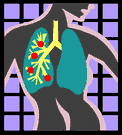 Pleural
mesothelioma is the mesothelima that deals with the lungs. Two types exist: Pleural
mesothelioma is the mesothelima that deals with the lungs. Two types exist:
- Malignant
(cancerous)
- Benign (not)
Benign mesothelioma
can often be removed surgically, are generally not life-threatening, and
are not usually related to asbestos exposure.
Pleural mesothelioma
can occur because of a long-term exposure to Asbestos. "Asbestos"
refers to a family of magnesium-silicate mineral fibers that have been
commonly used for insulation and in the shipbuilding and construction industries.
Interestingly, a history of asbestos exposure is found in 80 percent of
patients who present with mesothelioma.
Other factors
that may contribute towards pleural mesothelioma include:
- chronic
lung infections
- tuberculous
pleuritis
- radiation
(Thorotrast)
- exposure
to the simian virus 40 (SV40) or mineral fibers (Zeolite).
Although
tobacco smoking has not been associated with the development of mesotheliomas,
the combination of smoking and asbestos exposure greatly increases the
risk of lung cancer.
The condition
itself is a cancer of the cells that make up the pleura or lining around
the outside of the lungs and inside of the ribs. Its only known cause in
the U.S. is previous exposure to asbestos fibers, including chrysotile,
amosite or crocidolite. This exposure is likely to have happened twenty
or more years before the disease becomes evident, since it takes many years
for the disease to "incubate." It is the most common type of
mesothelioma, accounting for about 75% of all cases.
The first
step in verifying pleural mesothelioma usually is a chest x-ray or CT scan.
The next step is a bronchoscopy - this involves a viewing scope which the
doctors use to look inside the lungs.
The actual
diagnosis itself usually requires removing and analyzing a piece of tissue
through a biopsy. This could be a needle biopsy, an open biopsy, or through
a tube with a camera (thoracoscopy or chest scope.) The tissue sample is
tested by a pathologist.
Fluid build-up
from the pleural effusion can generally be seen on a chest x-ray and heard
during a physical examination. This is important because there are also
benign pleural effusions and other tumors that have a similar appearance
to mesothelioma such as pneumonia.
The spread
of the tumor over the lung pleura will thicken it, reducing the flexibility
of the pleura and encasing the lungs in an increasingly restrictive space.
This makes breathing more difficult. At first a person with mesothelioma
may be breathless only when he or she exercises, but as lung function drops,
he or she can become short of breath even while resting.
The tumor
spreads by direct invasion of surrounding tissue. As it spreads inward
it can compress the lungs. As the tumor spreads outward it can invade the
chest wall and ribs, and this can be extremely painful.
Currently
we do not know exactly how and why asbestos fibers cause mesothelial cells
to become abnormal (malignant or cancerous.) Many clinical studies are
dedicated to this.
As of yet,
there is no known cure for malignant mesothelioma. The prognosis depends
on various factors, including the size and stage of the tumor, the extent
of the tumor, the cell type, and whether or not the tumor responds to treatment.
More resources
regarding plural mesothelioma are found at:
Additionally,
consider perusing The
Treatment of Malignant Pleural Mesothelioma with Gene Modified Cancer Cells.
Pleural Mesothelioma
is the most common version of the cancer. But how is it really diagnosed?
It's time now for:
Next >
Chapter 4 - Mesothelioma Diagnosing
[
Return to top ]
______________________________
|
 Pleural
mesothelioma is the mesothelima that deals with the lungs. Two types exist:
Pleural
mesothelioma is the mesothelima that deals with the lungs. Two types exist: